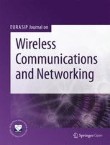EURASIP Journal on Wireless Communications and Networking welcomes submissions to the special issue on 'Dynamic Spectrum Access and Cognitive techniques for 5G'.
Research, requirement analysis and initial standardization work towards the 5th generation of cellular systems have now been under way for a few years. The system requirements, ranging from extremely low set up and end to end delay, to the perception of infinite capacity will need novel system architecture solutions. More importantly, these requirements will increase the demand on wireless spectrum, further accelerating the spectrum scarcity problem. There has been agreement that fixed spectrum allocation and usage commonly adopted today are a bottleneck to 5G requirement fulfillment. Both academic and regulatory bodies have focused on dynamic spectrum access and or dynamic spectrum usage to optimize scarce spectrum resource.
These 5G systems will serve classical cellular services, but a large portion of traffic will be fed by machines and things. This machine type communication has yet specific requirements. They are much more delay sensitive and the fact that the expected tens of billions of devices will need to be reliably connected further increases the problem scale.
Cognitive radio, with the capability to flexibly adapt its parameters, has been proposed as the enabling technology for unlicensed secondary users to dynamically access the licensed spectrum owned by legacy primary users on a negotiated or an opportunistic basis. It is now perceived in a much broader paradigm that will contribute to solve the resource allocation problem that 5G requirements raise.
5G is expected to address a 1000x capacity compared to today’s networks, whereas available spectrum resource will, by far, not grow in the same proportion, enabling only a few new portions or frequency bands. New technologies will have to be researched and tested in order to exploit this scarce and already crowded spectrum. Besides, the convergence of cellular systems with the Internet of Things and machine-to-machine communications will require a new technology bundle in order to enable a flexible service delivery over flexible networks to optimize spectrum usage and power consumption. We believe that dynamic access, flexible radio and cognitive approaches (in a wide sense) addressed by this special issue can help address these challenges.
Potential topics include but are not limited to:
- 5G
- Spectrum Access
- Flexible Radio
- Cognitive Radio
- Spectrum Policy
Submission Instructions
Before submitting your manuscript, please ensure you have carefully read the submission guidelines for EURASIP Journal on Wireless Communications and Networking. The complete manuscript should be submitted through the EURASIP Journal on Wireless Communications and Networking submission system. To ensure that you submit to the correct thematic series please select the appropriate thematic series in the drop-down menu upon submission. In addition, indicate within your cover letter that you wish your manuscript to be considered as part of the thematic series on 'Dynamic Spectrum Access and Cognitive techniques for 5G'. All submissions will undergo rigorous peer review and accepted articles will be published within the journal as a collection.
Deadline for submissions: 31 October, 2016
Lead Guest Editor
Dominique Noguet, CEA-LETI, France
Guest Editors
Klaus Moessner, University of Surrey, UK
Danijela Cabric, University of California, Los Angeles (UCLA), USA
Masayuki Ariyoshi, NEC Corporation, Japan
Submissions will also benefit from the usual advantages of open access publication:
- Rapid publication: Online submission, electronic peer review and production make the process of publishing your article simple and efficient
- High visibility and international readership in your field: Open access publication ensures high visibility and maximum exposure for your work - anyone with online access can read your article
- No space constraints: Publishing online means unlimited space for figures, extensive data and video footage
- Authors retain copyright, licensing the article under a Creative Commons license: articles can be freely redistributed and reused as long as the article is correctly attributed
For editorial enquiries please contact editorial@jwcn.eurasipjournals.com
Sign up for article alerts and news from this journal to keep updated on articles published in EURASIP Journal on Wireless Communications and Networking - including articles published in this thematic series!
